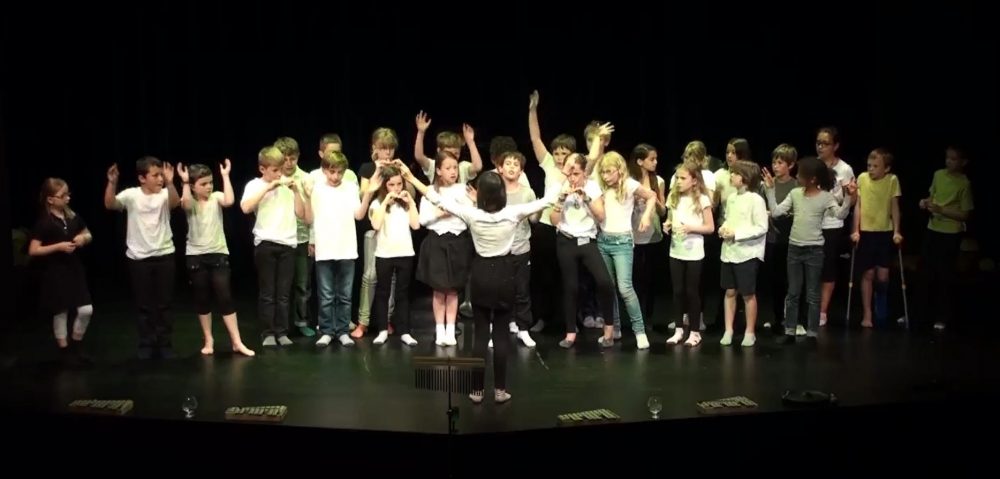Summary
A set of exercises for voice and body designed to awaken and explore the voice by opening the imagination. These exercises can be a vocal warm-up or be followed at any time during a musical session.
Examples that will make you want to invent more.
Duration: about 20 seconds per exercise
Age: from age 6
Key words creativity and entrepreneurship: Exploration, Imagination, Enthusiasm, Working in teams, Risk of the performance
Description
01 – Hello
Open your voice and have fun with the word “Hello”.
Any word or text can be used for this exercise.
Competencies
The pupils are able to:
- explore the different registers of the voice of bass to treble
- enter into a character
- dare to use different tones of voice
- play with the voice
02 - Body Stretches
- Stretch like a cat, be bold and make the sound that comes with the movement (trapped, tense, released, etc.)
03 - Shoulders and posture
Hang the shoulders on an imaginary clothesline and let the arms hang like wet socks
Competencies:
The pupils are able to:
- become aware of one’s body by isolating an immobile part of the body and feel the freedom of movement of the other parts of the body.
04 - Deflate the lungs
Exhale the all the air of the lungs to feel the openness and well being that follows apnea. Exhalation is an active moment, inhalation is a passive moment and if possible not too noisy.
05 - Projection unvoiced consonants
Accompany the gesture and give it space.
Make sure of the tone of the consonants, relative to the elasticity of the diaphragm
The hand gestures that accompanies the exhalation should be adapted to each consonant (friction for fricatives, a light tap with the fingertips to project the explosive consonants, etc.).
Competencies
The pupils are able to:
- become aware of the exhalation and the resonance of the sound produced.
06 - Crumbs on the windowsill
Arms rest on the edge of an imaginary window, exhale strongly over the entire surface, from left to right, to blow away imaginary crumbs or dust
The arms stabilize the posture and the head is loose.
The exercise helps breathing with consonants
07 – Light tapping
Tap to either a measured or free rhythm, at different speeds, varying the parameters (speed up, slow down, loud, soft, propose breaks, etc.) to keep paying attention to what we are doing, to ourselves and to others.
Competencies
The pupils are able to:
- awaken the body to become fully in the present from head to toe;
- promote receptivity.
08 - Trunk of an elephant
An image to support a small element of self-massage of the trapezoids
09 – Stamping
Competencies
The pupils are able to:
- generate the maximum amount of energy in a short time;
- be in contact with the ground over a small area;
- return to calm breathing after a moment of effort.
10 – The squirrel and its hazelnut sound
The squirrel guards its hazel nut jealously and makes a noise with it discreetly.
The sound is completely nasal, it is stopped by blocking both nostrils simultaneously with the fingertips (base of the tongue against the veil of the palate as in ping pong [ŋ]). It is fun to go through his “sonorous range” from the bass to the treble.
-Working with nasality.
11 - Pick the stars from the sky
The Stars are far away, unattainable or almost like the treble, pluck don’t snatch, (the sound is selective and is smooth without a glottal stop).
We run through the entire range from one extreme to the other, with delicacy.
The choice of this imagery allows us to search for a sound that is not harsh. Equal attention is given to the vocal line (we do not leave star with our eyes and do not stop listening to the voice).
12 – Moto con moto
Sound employed: [ʙ] bilabial vibration voiced (brrr as in a shudder).
We share the noise (free intonation) of children’s games (imitate the sound of a motor of a vehicle) to slide towards the edge (precise intonation).
We can play freely with the pitch (bend, curves, peaks, etc.), to accompany the movement and also with the quality of the sound (old tractor, luxury car, race car, motorcycle etc.).
13 - Engine on 'V'
All voiced consonants lend themselves to singing exercises (sirens or melodic motifs): [v], [z], [m], [ʒ], etc
14 – Car
Exploring the voice and the imagination
15 - Creaking door
Manage the subglottic pressure, which is excellent for reducing breathing in the voice
Allows the production of sounds which slide towards the high notes without exhalation
The creaky door raises awareness of the strength necessary for success in this exercise
16 - Breathing, vocalising, with gestures, creating an imaginary language
Encourage students to make vocal sounds that are picked up by the imitating group in imitation.
17 - To make a sound
Be able to return to a pitch, hold it and transmit it.
18 – Sounds that want to escape from of my mouth
I let it sing through me
“There’s a lot going on in my mouth, there are plenty of sounds in my mouth just waiting to get out … »
Give the gesture the sound it expresses or represents
We can be inspired and inventive to the extreme
Competencies
Each exercise develops a particular competency, see individual exercises.
The pupils are able to:
- explore the different registers of the voice of bass to treble;
- enter into a character;
- dare to use different tones of voice;
- play with the voice;
- awaken the body to become fully in the present from head to toe;
- promote receptivity;
- …
Materials
No equipment needed.
Module Overview
|
